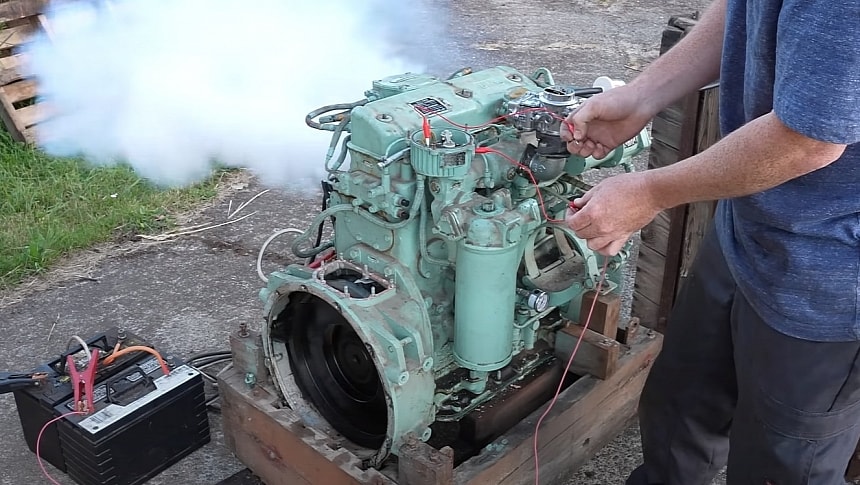When talking about Rolls-Royce engines, we usually think about the company's old inline-six and V8 automobile units and the Merlin V12 aero powerplant. The latter is quite iconic, having powered famous WW2 fighters like the Spitfire, Hurricane, Mustang, and Lancaster. But did you know Rolls-Royce also built a series of engines for military vehicles?
It's called the "B range" and first surfaced on the company's drawing board during WW2. Developed was completed in 1947, and production included no fewer than five versions. The B40, a 2.8-liter inline-four, was the smallest of the bunch and delivered 80 horsepower. Rolls-Royce also built 4.3- and 4.9-liter inline-six mills (the B60 and B61). The former was used in light armor trucks like the Daimler Ferret, Humber Pig, and Humber Hornet.
The lineup also included a pair of inline-eight engines. The B80 displaced 5.7 liters and produced 160 horsepower, while the B81 came in at 6.5 liters and generated 185 horses. The B80 was used in six-wheeled Alvis carriers and an armored recovery vehicle based on the Centurion tank. The B81 powered bigger trucks and British Army FV430-series vehicles.
The Rolls-Royce Phantom IV was the only automobile fitted with the inline-eight version of the "B range" engine. The company produced only 18 vehicles from 1950 to 1956.
But I'm actually here to talk about the B40, the smallest and most common iteration of the "B range." Produced in about 20,000 units, the B40 was mostly used in the Austin Champ. Inspired by the Willys MB Jeep, the Champ was produced from 1951 to 1956. Austin Motor Company built around 11,000 units for the British Army. And because Rolls-Royce couldn't keep up with demand, Austin began producing the unit themselves.
In addition to the Champ, the B40 also powered trailer-mounted generators and cranes. And as it turns out, Austin also supplied it as a crate engine. One such unit recently surfaced in the United States. It was still unused and in its original box, and it went under the hammer at a public auction for scrap money.
The new owner attended the event looking for excavator parts. Luckily, he runs a YouTube channel and decided to dedicate a full episode to the Rolls-Royce powerplant.
Locked in a box for a whopping 72 years (as of 2024), the four-cylinder emerged into the light with all sorts of issues associated with long-term storage. It was stuck, had water in the oil pan, and was missing its original carburetor. But that didn't stop our host from taking it apart and giving the old lump a thorough cleaning. And surprisingly enough, the B40 fired right up once it got a carburetor, fresh oil and gasoline, and a starter.
What looked like an antique engine destined to be sold for parts turned out to be a solid powerplant that could be used in a vehicle. It's unclear what will happen to this B40, but it's a pretty rare engine in the United States—to the point where there's no market for it. Check it out in the video below.
The lineup also included a pair of inline-eight engines. The B80 displaced 5.7 liters and produced 160 horsepower, while the B81 came in at 6.5 liters and generated 185 horses. The B80 was used in six-wheeled Alvis carriers and an armored recovery vehicle based on the Centurion tank. The B81 powered bigger trucks and British Army FV430-series vehicles.
The Rolls-Royce Phantom IV was the only automobile fitted with the inline-eight version of the "B range" engine. The company produced only 18 vehicles from 1950 to 1956.
But I'm actually here to talk about the B40, the smallest and most common iteration of the "B range." Produced in about 20,000 units, the B40 was mostly used in the Austin Champ. Inspired by the Willys MB Jeep, the Champ was produced from 1951 to 1956. Austin Motor Company built around 11,000 units for the British Army. And because Rolls-Royce couldn't keep up with demand, Austin began producing the unit themselves.
In addition to the Champ, the B40 also powered trailer-mounted generators and cranes. And as it turns out, Austin also supplied it as a crate engine. One such unit recently surfaced in the United States. It was still unused and in its original box, and it went under the hammer at a public auction for scrap money.
The new owner attended the event looking for excavator parts. Luckily, he runs a YouTube channel and decided to dedicate a full episode to the Rolls-Royce powerplant.
Locked in a box for a whopping 72 years (as of 2024), the four-cylinder emerged into the light with all sorts of issues associated with long-term storage. It was stuck, had water in the oil pan, and was missing its original carburetor. But that didn't stop our host from taking it apart and giving the old lump a thorough cleaning. And surprisingly enough, the B40 fired right up once it got a carburetor, fresh oil and gasoline, and a starter.
What looked like an antique engine destined to be sold for parts turned out to be a solid powerplant that could be used in a vehicle. It's unclear what will happen to this B40, but it's a pretty rare engine in the United States—to the point where there's no market for it. Check it out in the video below.











